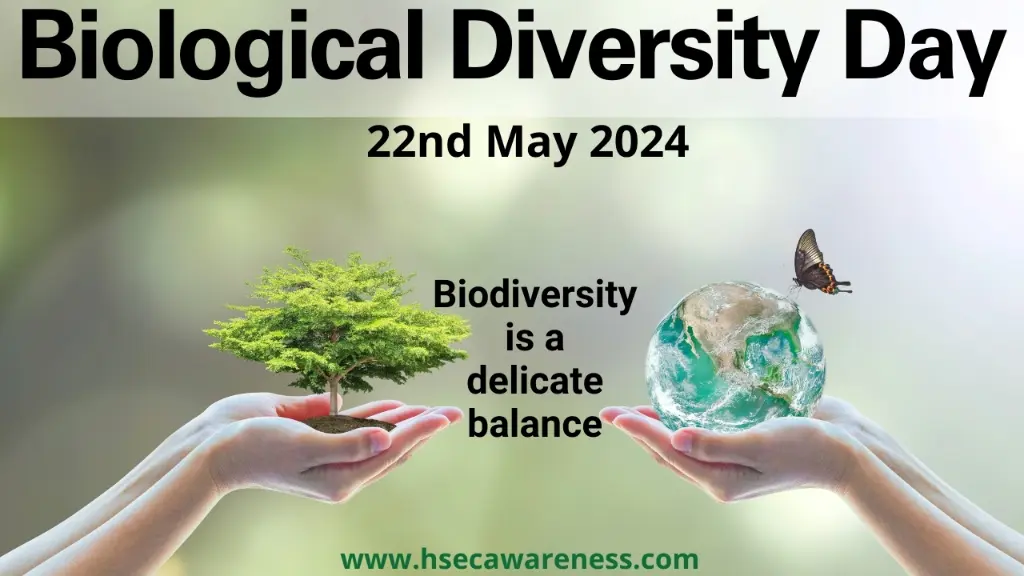Through this article let’s uncover the importance of biodiversity, grasp the various types of biodiversity, and delve into conservation practices on International Biodiversity Day 2024.
Moreover, explore famous quotes on world biodiversity day and dive into the most frequently asked questions associated with the international day for biological diversity.
1. Introduction of International Biodiversity Day 2024:
In 2000, the UN General Assembly officially announced May 22nd to be the International Day for Biodiversity (IDB). Since then, International Day for Biological Diversity or world biodiversity day is a celebration dedicated to recognizing and raising awareness about the incredible variety of life on Earth.
According to the National Geographic report at present, nearly 2.16 million species of organisms have been identified on our planet. Thus, Biodiversity Day provides an opportunity to appreciate the importance of biological diversity and the urgent need to conserve and protect it.
2. What is Biological Diversity or Biodiversity:
Biological diversity, or biodiversity, refers to the variety of life forms on Earth. It includes all the different plants, animals, microorganisms, and their habitats. It encompasses the diversity of genes, species, and ecosystems, all of which are interconnected and essential for the functioning of our planet.
For instance, we have observed around us so many different types of plants, animals, insects, and organisms (including those which we cannot see with our naked eyes), these are all collectively referred to as biodiversity or biological diversity. And the complexity of this vast immense diversity is the reason that keeps it sustainable on its own.
3. The Importance of Biological Diversity:
Biological diversity plays a vital role in maintaining the balance of ecosystems and the well-being of all living organisms. Everything an organism uses from birth till the day it dies comes from this immense diversity.
I think now you got a glimpse of the importance of biological diversification. Here are some elaborated key reasons with examples of why biodiversity is crucial:

3.1 Ecosystem Stability:
Biodiversity ensures the stability of ecosystems by supporting various ecological processes such as nutrient cycling, pollination, water purification etc. A rich and diverse ecosystem is more resilient to environmental changes and disturbances i.e., an ecosystem cannot be destroyed easily.
It can undo the damages caused or what happened to it. The more diverse an ecosystem is, the better chance it has of survival. As the old saying goes” The more the merrier”.
Let’s take an example to explain this in a better and simple way. Imagine a forest where only one type of tree grows. If a disease or pest attacks that tree, the entire forest could be wiped out. But in a diverse forest with many different types of trees, if one species is affected, other species can still survive and keep the ecosystem functioning.
3.2 Food and Agriculture:
Biodiversity is the foundation of the food and agricultural system we use for our survival. Different plant and animal species provide us with essential resources, including food, medicine, and raw materials.
In every meal, we use so many different or diverse things to cook, and each of those ingredients comes from so many different organisms. The spices we use to make our food tasty, the milk we consume, the eggs we eat, and even the water we drink are a part of the biodiversity.
If we lose certain species, it could impact our food supply and make it harder for us to find the things we need to eat.
3.3 Economic Benefits:
Biodiversity is of great economic importance. A healthy ecosystem is a base for a wide range of economic, environmental, and aesthetic goods and services. Most of the industries, such as tourism, pharmaceuticals, and biotechnology, rely on the diverse array of natural resources and ecosystem services that biodiversity offers.
Even everything we use in our day-to-day life is a part of the biodiversity. In the simplest form of example, forests are home to many different trees, and we use their wood to make furniture, houses, and paper. Some plants also have medicinal properties and can be used to develop medicines that help us stay healthy. Similarly, there are endless resources in our ecosystem.
Researchers have put an average price tag of US $ 33 trillion per year cost of the ecosystem services we use, and we take these services for granted just because it’s free. Looking at this figure we can comprehend the importance of the ecosystem and its benefits or services.
3.4 Climate Regulation:
Ecosystems with high biological diversity contribute greatly to climate regulation by sequestering carbon dioxide, a greenhouse gas responsible for climate change. Greenhouse gases include not only carbon dioxide but many other gases like Methane, CFC, Nitrous oxide, etc.
Forests, Wetlands, and oceans act as carbon sinks and help mitigate the impacts of climate change.
It has been observed that in the recent past, the level of carbon dioxide has increased dramatically and this increase in CO2 level is the prime reason that has led to considerable heating of Earth leading to global warming.
Since the ecosystem has the property of self-regulation to maintain its stability. Thus, it is regulating climate so that it doesn’t worsen.
4. Why We Celebrate International Day for Biological Diversity:
Each year on May 22nd, the International Day for Biological Diversity is celebrated worldwide with a theme. The aim is to increase awareness and understanding of biodiversity’s importance and issues.
The official theme for the 2024 International Day for Biological Diversity has not yet been announced. We will update you once it has been determined and announced by The Convention on Biological Diversity (CBD).
The theme of the previous year i.e. 2023 was “From agreement to action: Build back Biodiversity”
This day provides an opportunity to educate people about the importance of biodiversity conservation and encourage action to protect it and not to over-exploit it. By celebrating this day, we can inspire individuals, communities, and governments to take steps towards preserving the natural heritage of our planet.
Due to ignorance, some species have already been extinct, and some are on the verge of extinction known as endangered species. But we can learn how to conserve them, we just need a positive motivation towards saving our vast diversity and this day is celebrated to motivate everyone towards conservation, understanding, and awareness of biological diversity.
5. Types of Biological Diversity:
There are different types of biodiversity, and each type helps make our planet unique and special. We will explore three main types of biological diversity in this article:
5.1 Species Diversity:
Species diversity refers to the variety of different species in each area. A species is a group of living things that can reproduce and have offspring together.
Let’s think about the many species of birds, insects, trees, and flowers you might see in your surroundings. Each species has its own characteristics and plays a role in the ecosystem. The more species there are in an area or ecosystem, the richer the biodiversity.
For example, a forest may have a diverse range of tree species, birds, insects, and mammals. In the same way, a water body like an ocean, river, pond, lake, etc. can have a diverse range of fishes, phytoplankton, zooplankton, and other marine habitats. So, we can say that every ecosystem has its unique diversification.
5.2 Genetic Diversity:
Genetic diversity refers to the variety of genes within a species. Genes are like the instructions that determine how a living thing looks and behaves. Just like we have different traits inherited from our parents, animals and plants also have different genes that make them unique.
Genetic diversity is essential because it helps species adapt to changes in their environment. For instance, some plants may have genes that make them resistant to certain diseases, allowing them to survive and reproduce.
In the recent events of the COVID pandemic, we all have heard about different strains of the coronavirus, these different strains are considered to be genetic diversity. In a similar way many other organisms have different strains, or we can say different varieties of strains are found making it a genetically diverse organism. For example, the rice and wheat that we consume are available in different varieties all because of genetic diversity.
5.3 Ecosystem Diversity:
Ecosystem diversity refers to the variety of ecosystems in each region or on a global scale. An ecosystem is a community of living things, such as plants, animals, and microorganisms, interacting with each other and their environment.
For example, think about a forest, a pond, or a coral reef. Each ecosystem is home to various species and has its own set of conditions, such as temperature, rainfall, and soil type. Protecting different ecosystems is important because they provide different services, like clean air, water, and habitats for animals.
Ecosystem diversity is an important aspect because every organism requires its habitable ecosystem. For example, a fish requires a water ecosystem while a deer requires a forest ecosystem or a grassland ecosystem. And because of this ecosystem diversity, we get to observe a variety of habitats and niches.
6. Biodiversity and Conservation or How biodiversity can be conserved?
Conserving biodiversity means taking action to protect and preserve the variety of life on Earth. It is important because biodiversity provides us with many benefits and helps keep our planet healthy.
Preserving or conserving biodiversity is a shared responsibility that requires collective efforts from individuals, communities, organizations, and governments. Below are a few suggested ways in which biodiversity can be conserved:
6.1 Protecting Natural Habitats:
Conserving and protecting natural habitats is crucial for maintaining biodiversity.
A habitat is a place where plants and animals live. For example, forests, wetlands, coral reefs, and grasslands are all habitats. By preserving these habitats, we ensure that the plants and animals that call them home can thrive.
This can be done by creating national parks, wildlife sanctuaries, and nature reserves where human activities are limited.
6.2 Sustainable Land and Resource Management:
We rely on natural resources like forests, water, and minerals for our daily needs. However, it’s important to use these resources sustainably, which means using them in a way that doesn’t harm the environment or deplete them completely.
For instance, cutting down trees in a forest should be done carefully and in a way that allows new trees to grow, ensuring the habitat and the species within it are not harmed.
Implementing sustainable land and resource management practices can help reduce the negative impacts of human activities on biodiversity. This involves promoting sustainable agriculture, responsible forestry, and minimizing habitat destruction.
6.3 Preventing Pollution:
Pollution can harm and even destroy biodiversity. It’s important to reduce pollution by properly disposing of waste, recycling, and using eco-friendly products. For example, chemicals from factories and litter thrown into rivers can harm aquatic life and disrupt ecosystems. By being mindful of our actions and making environmentally friendly choices, we can help protect biodiversity.
6.4 Promoting Conservation Education and Awareness:
Increasing public awareness and knowledge about the importance of biodiversity is essential.
By learning about different species, ecosystems, and their interconnections, we develop a deeper appreciation and understanding of the need for conservation. We can share this knowledge with others, raise awareness, and inspire action to protect biodiversity.
6.5 Supporting Community Participation:
Engaging local communities in conservation efforts is vital for the long-term success of biodiversity conservation. Involving communities in decision-making processes, providing alternative livelihood options, and promoting sustainable practices can create a sense of ownership and responsibility.
6.6 Combating Illegal Wildlife Trade:
Illegal wildlife trade poses a significant threat to biodiversity, particularly for endangered species. Strengthening law enforcement, promoting international cooperation, and raising awareness about the consequences of wildlife trafficking are essential steps in combating this issue.
6.7 Research and Monitoring:
Continuous research and monitoring of biodiversity are crucial for understanding ecological patterns, identifying threats, and implementing effective conservation strategies. Scientific studies provide valuable insights into the status of different species and ecosystems, helping prioritize conservation actions.
6.8 Collaboration and International Cooperation:
Biodiversity conservation requires global collaboration and international cooperation. Governments, organizations, and individuals need to work together to establish and enforce policies, share knowledge and resources, and support initiatives that promote biodiversity conservation.
7. What are the ways to protect and preserve species:
In the world of biodiversity conservation, there are two important ways we can protect and preserve species: In-situ Conservation and Ex-situ Conservation. Let’s understand what these terms mean and why they are performed:
7.1 In-situ Conservation:
In-situ conservation means protecting and preserving species in their natural habitats. It involves creating and maintaining protected areas like national parks, wildlife sanctuaries, and nature reserves.
These areas provide a safe environment for plants, animals, and other organisms to live and reproduce.
In-situ conservation is important because it allows species to continue their natural life cycles and maintain their ecological roles within the ecosystem.
In-situ conservation is performed under the following circumstances:
- When a species is endangered or at risk of extinction due to habitat loss, pollution, or other threats.
- When a specific area is recognized as having high biodiversity and needs protection to prevent the loss of species and habitats.
- When a species plays a crucial role in the ecosystem, such as being a pollinator, seed disperser, or keystone species.
7.2 Ex-situ Conservation:
Ex-situ conservation involves the conservation of species outside their natural habitats. It includes activities like captive breeding, seed banks, and botanical gardens.
Captive breeding programs aim to breed and raise endangered species in a controlled environment, such as a zoo or a breeding center, to increase their population.
Seed banks store and preserve seeds of different plant species, ensuring their availability for future use. Botanical gardens cultivate and showcase a wide variety of plant species for research, education, and conservation purposes.
Ex-situ conservation is performed under the following circumstances:
- When a species is critically endangered or facing imminent extinction in the wild.
- When a species requires special care and attention to recover its population, such as through breeding programs.
- When there is a need to preserve genetic diversity or protect rare and threatened plant species.
Both in-situ and ex-situ conservation are important because they complement each other in preserving biodiversity. In-situ conservation protects species within their natural ecosystems, while ex-situ conservation provides a safety net for species that are at high risk or no longer have viable populations in the wild.
8. How can you contribute as an Individual or Community:

9. Conclusion:
The International Day for Biological Diversity is an important occasion that reminds us about the beauty, importance, and delicacy of the Earth’s biodiversity. It teaches us to appreciate the incredible variety of life on our planet and understand why it is so crucial to protect it.
By learning about the different types of biodiversity and why they matter, we can make a positive impact. Whether it’s through protecting habitats, reducing pollution, using resources sustainably, or supporting conservation efforts, we all have a role to play in preserving this precious natural heritage.
Let’s embrace our responsibility to care for the amazing diversity of life that surrounds us. By doing so, we can ensure a healthy and vibrant future for ourselves and the generations to come. Together, we can make a difference and protect the incredible gift of biodiversity that our planet has bestowed upon us.
For future updates, suggestion and discussion, please connect with us on Facebook, Twitter & Linkedin.
Click the link to read more topics on 2024 Calendar and Important Days for HSE Professionals.






